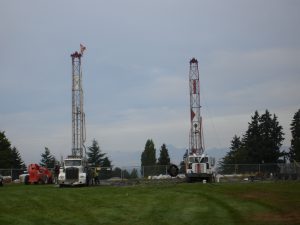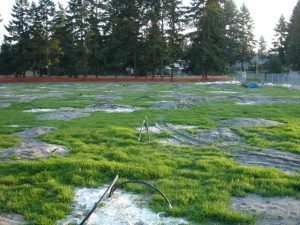Insights · November 11th, 2008
When alternative energy is discussed, a potential energy source that receives less attention is geothermal. However, if I walk a few blocks from my home to Lake Washington High School I can see a geothermal heat pump system being installed in preparation for a complete re-build of this school.
Ground-based geothermal differs from the kind of geothermal we usually think of, which is hot-water based. About 10% of the earth has sites where volcanic activity is sufficient to heat water that could be tapped to produce energy. At the same time, everywhere the earth maintains a fairly constant temperature of 50F about 6 feet down.
Using this constant earth temperature is a simple engineering proposition of drilling holes, running pipe down and back, sending a liquid through the pipes, and using the temperature differential in a heat pump. In the summer the earth assists in cooling, in the winter it assists in heating.
Such systems are appropriate to homes and commercial buildings both. The Lake Washington School District has been using such a system in another of its schools, Redmond High School, since 2003, saving an estimated $66,000 per year in energy costs. The new system next door will generate comparable savings.
For a home owner, the cost of installing such a system will be in the range of 50% more expensive than a typical furnace and air-based heat pump system, but payback is typically estimated in five years. In addition, there are various subsidies available to assist in the initial cost.
Installation is a messy job, as you can see in these photos I snapped the other day, but the result is a major contribution to a sustainable future.
Glen Hiemstra is a futurist speaker, consultant, blogger, internet TV show host and founder of Futurist.com. To arrange for a speech contact Futurist.com.




